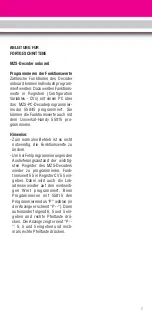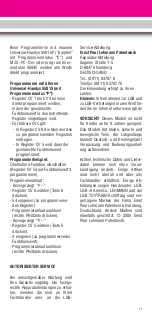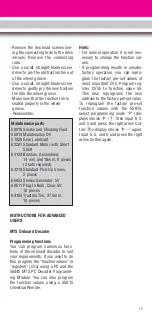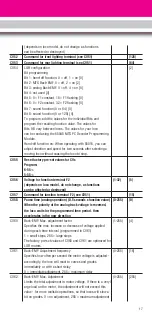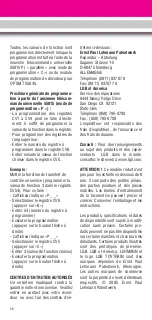
17
(depends on loco model, do not change, as functions
can be affected or destroyed)
CV52
Command for front lighting terminal (see CV51)
[128]
CV53
Command for rear lighting terminal (see CV51)
[64]
CV54
LGB configuration
[2]
Bit programming
Bit 1: hand-off function, 0 = off, 1 = on [0]
Bit 2: MTS Back-EMF, 0 = off, 2 = on [2]
Bit 3: analog Back-EMF, 0 = off, 4 = on [0]
Bit 4: not used [0]
Bit 5: 0 = F1 constant, 16 = F1 flashing [0]
Bit 6: 0 = F2 constant, 32 = F2 flashing [0]
Bit 7: sound function (0 or 64) [0]
Bit 8: sound function (0 or 128) [0]
To program, add the values for the individual Bits and
program the resulting function value. The values for
Bits 5-8 vary between locos. The values for your loco
can be read using the 55045 MTS PC Decoder Programming
Module.
Hand-off function on: When operating with 55015, you can
adjust direction and speed for two seconds after selecting a
moving loco without causing the loco to stop.
CV55
Reset factory pre-set values for CVs
Program:
6-55->
5-55->
CV56
Voltage for function terminal F2
(1-32)
[5]
(depends on loco model, do not change, as functions
can be affected or destroyed)
CV57
Command for function terminal F2 (see CV51)
[15]
CV58
Pause time (analog operation) (0.5 seconds x function value) (0-255)
[0]
When the polarity of the analog track voltage is reversed,
the loco waits for the programmed time period, then
accelerates in the new direction
CV60
Back-EMF: Max. adjustment factor
(1-255)
[4]
Specifies the max. increase or decrease of voltage applied
during each time interval (programmed in CV61)
1 = small steps, 255 = large steps
The factory pre-set values of CV60 and CV61 are optimized for
LGB motors.
CV61
Back-EMF: Adjustment frequency
(0-255)
[16]
Specifies how often per second the motor voltage is adjusted -
accordingly, the loco will react to curves and grades
immediately or with a short delay
0 = immediate adjustment, 255 = maximum delay
CV62
Back-EMF: Max. Adjustment
(0-255)
[255]
Limits the total adjustment in motor voltage. If there is a very l
arge load on the motor, the adjustment will not exceed this
value - for more realistic operations, so that locos will slow a
bit on grades. 0 = no adjustment, 255 = maximum adjustment
Summary of Contents for 20271
Page 26: ...29...




